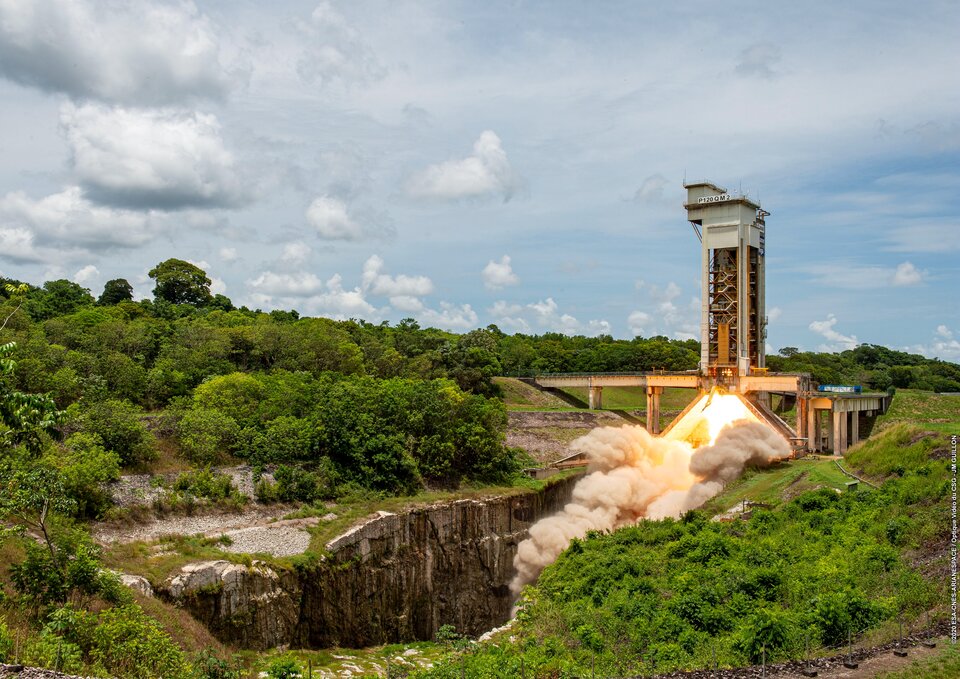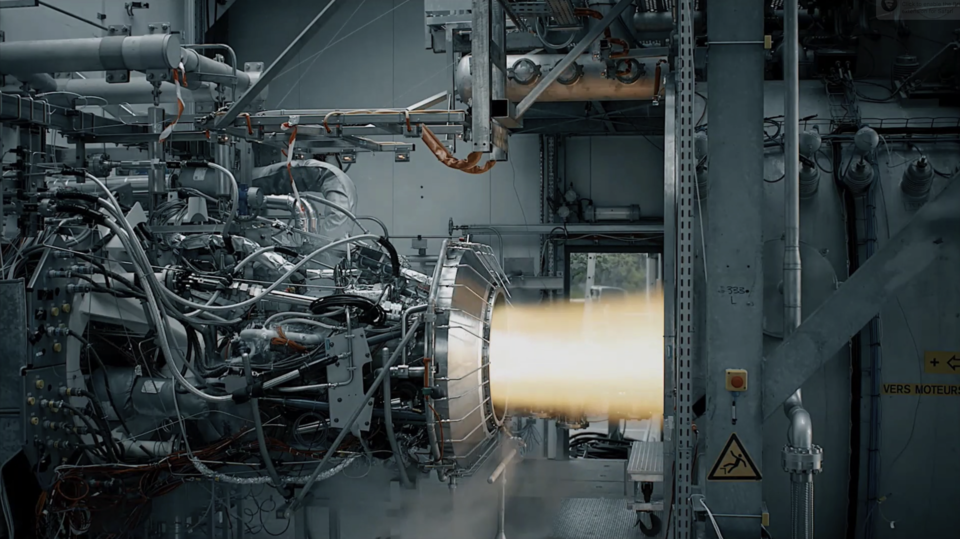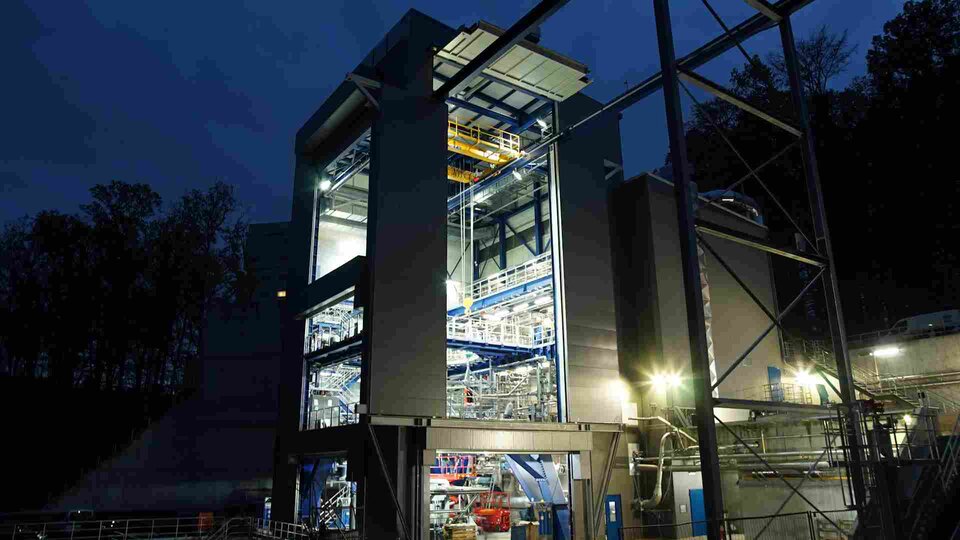17.10.2020

All three engines developed to power Europe’s future Ariane 6 rocket have completed extensive tests – the P120C solid rocket motor for the boosters, the Vulcain 2.1 engine for the core stage and the Vinci for the upper stage.
Ariane 6 in the four-booster version will stand 63m tall, will weigh 900 tonnes and have the liftoff power equivalent to 12 Airbus A380 engines roaring at takeoff.
P120C – Europe’s new solid propulsion workhorse

Two or four P120Cs, depending on the configuration, will be strapped onto Ariane 6’s core stage as boosters for liftoff.
The P120C is Europe’s new solid propulsion workhorse. The ‘C’ stands for ‘common’ as P120C will be used on both ESA-developed launcher systems – Vega-C as well as Ariane 6. It has been developed by Europropulsion, which is owned jointly by Avio and ArianeGroup.
Rocket motors that contain solid fuel burn until the fuel is depleted. Simple and powerful, this form of propulsion is often an operations low-cost option for raw power, used most often at the liftoff stage. Each P120C motor provides about 4500 kN of thrust.
P120C is 13.5 m long and 3.4 m in diameter and weighs 11 tonnes. Its 25 cm thick casing is made using a carbon composite material and it is built in one segment at Avio’s Colleferro rocket factory in Italy. ArianeGroup in France developed the advanced P120C nozzle, while Nammo in Norway provided the igniter. Efficient production methods have shortened production cycles and optimised costs.
Three models of the P120C have completed hot firings at Europe’s Spaceport in French Guiana: the development model (DM1) in July 2018, the first qualification model (QM1) in January 2019 – the version which will be used on Vega-C’s maiden flight, and most recently the qualification model (QM2) in October 2020 for use on the maiden flight of Ariane 6. The production of the motor components for the Vega-C flight model is almost complete.
The final step is to demonstrate that new production facilities are fully up and running to meet demand.
Vulcain 2.1 – core stage engine

Ariane 6’s core stage cryogenic engine, the Vulcain 2.1, is fueled by liquid oxygen–hydrogen. It delivers 1371 kN of thrust in vacuum to propel Ariane 6 in the first eight minutes of flight, up to an altitude of 200 km. It weighs the same as an Airbus A318 jet engine but provides more than 10 times the power.
The Vulcain 2.1 features a 3D-printed gas generator, a redesigned, simplified nozzle and a combustion chamber that can be ignited from the ground via the bottom of the nozzle instead of by pyrotechnic devices inside the motor, reducing the cost and weight.
Expensive liquid helium is no longer needed as it was for Vulcain 2.0 because heated oxygen in the exhaust lines now pressurises the oxygen tank.
The final qualification static firing test of Vulcain 2.1 in July 2019 in Lampoldshausen confirmed the functional and mechanical behaviour of this engine while upcoming combined tests will qualify Ariane 6 subsystems at stage and launcher level.
Vinci – reignitable upper stage engine

Vinci is Europe’s first expander cycle engine and will power Ariane 6’s upper stage. It is fueled by liquid oxygen–hydrogen and can be reignited up to five times. This increases the operational flexibility of Ariane 6 and ensures that the engine safely deorbits at the end of the mission.
The qualifying tests for the Vinci were completed in October 2018. This engine was successfully tested more than 140 times and reignited multiple times in succession in near vacuum to complete its qualification bringing a total of more than 14 hours of operation.

The Vinci engine will be integrated with the complete Ariane 6 upper stage at ArianeGroup facilities in Bremen, Germany. It will then be transported to the DLR German Aerospace Center in Lampoldshausen where the Ariane 6 upper stage will experience a simulated launch inside their new P5.2 facility.
“ESA with European industry have created three new engines to grow Europe’s independent access to space. We have increased performance, expanded our flexibility and become even more competitive. With all engine qualifications tests completed, we will now focus on remaining final phase activities for Ariane 6 and Vega-C maiden flights,” commented Daniel Neuenschwander, ESA Director of Space Transportation.
Quelle: ESA
+++
The Ariane 6 engines are now ready
Paris, October 15, 2020
-
The three engines for Europe’s new Ariane 6 launcher have now completed their qualification tests, following the successful qualification testing of the P120C solid propulsion engine on October 7 at Europe’s Spaceport in French Guiana
-
The qualification test campaigns for the Vinci and Vulcain 2.1 liquid propulsion engines were held in 2018 and 2019, respectively
-
The Vulcain 2.1 and Vinci engines, which will be powering the first Ariane 6, are ready to be mounted on the core stage in Les Mureaux and on the upper stage in Bremen
The future European launcher’s three types of engines use two different propulsion technologies:
-
- liquid hydrogen-oxygen propulsion for the Vulcain 2.1 core stage engine and the re-ignitable Vinci
engine on the upper stage;
-
- solid propulsion for the P120C engine fitted to the boosters which help propel Ariane 6 beyond the
gravitational pull of earth’s atmosphere.
With the successful final qualification of the P120C at the European Spaceport (CSG) in Kourou on October 7, the qualification models of three engines for Ariane 6 have now all been tested successfully.
“This is a major step in the development of the new European launcher. The engines are traditionally among the most complex and most strategic components of any space project. The success of the P120C in the Ariane 6 configuration is also the first ‘system’ test of our European launcher, which has thus passed one of the most critical stages in its development” said André-Hubert Roussel, CEO of ArianeGroup. “The Vulcain 2.1 and Vinci engines for the Ariane 6 maiden flight have already been delivered to the relevant sites in Bremen, Germany, and Les Mureaux France, for integration with their respective stage, having first undergone production completion firing tests, to ascertain proper functioning. I would like to express my warmest thanks to everyone at ArianeGroup and our industrial partners for this major success by the European space team, in a context that is difficult for everyone.
The solid-propellant P120C rocket will equip Ariane 62 (Ariane 6 in its configuration with two strap-on boosters) and Ariane 64 (four strap-on boosters) as well as the first stage of the Vega-C launcher. This third and last successful test of the solid propellant P120C rocket, in the Ariane 6 configuration, paves the way for final qualification of the P120C by the European Space Agency (ESA). Additionally, this last engine test was also the first “system” test of the booster for the new European launcher, whichfeatures a nozzle controlled by electric jacks powered by thermal cells (a world first in ignition by laser and optical fiber). The same test also validated the interactions between "ground" infrastructures and "on-board" equipment thanks to a new technology communication bus.
The Vulcain 2.1 core stage liquid propulsion engine, which produces a thrust of 140 metric tons (1,370 kN) have completed qualification tests in July 2019. The Vinci upper stage re-ignitable engine, with its 18 metric tons of thrust (180 kN), completed its qualification tests in October 2018.
Ariane 6 is a program managed and funded by the European Space Agency for which ArianeGroup is design authority and industrial prime contractor. ArianeGroup is responsible for development,
-
production with its industrial partners and operations via its subsidiary Arianespace. The French space agency CNES is responsible for construction of the launch pad in Kourou, French Guiana.
ArianeGroup coordinates an industrial network of more than 600 companies in 13 European countries, including 350 small and medium enterprises (SMEs).
Quelle: arianespace
